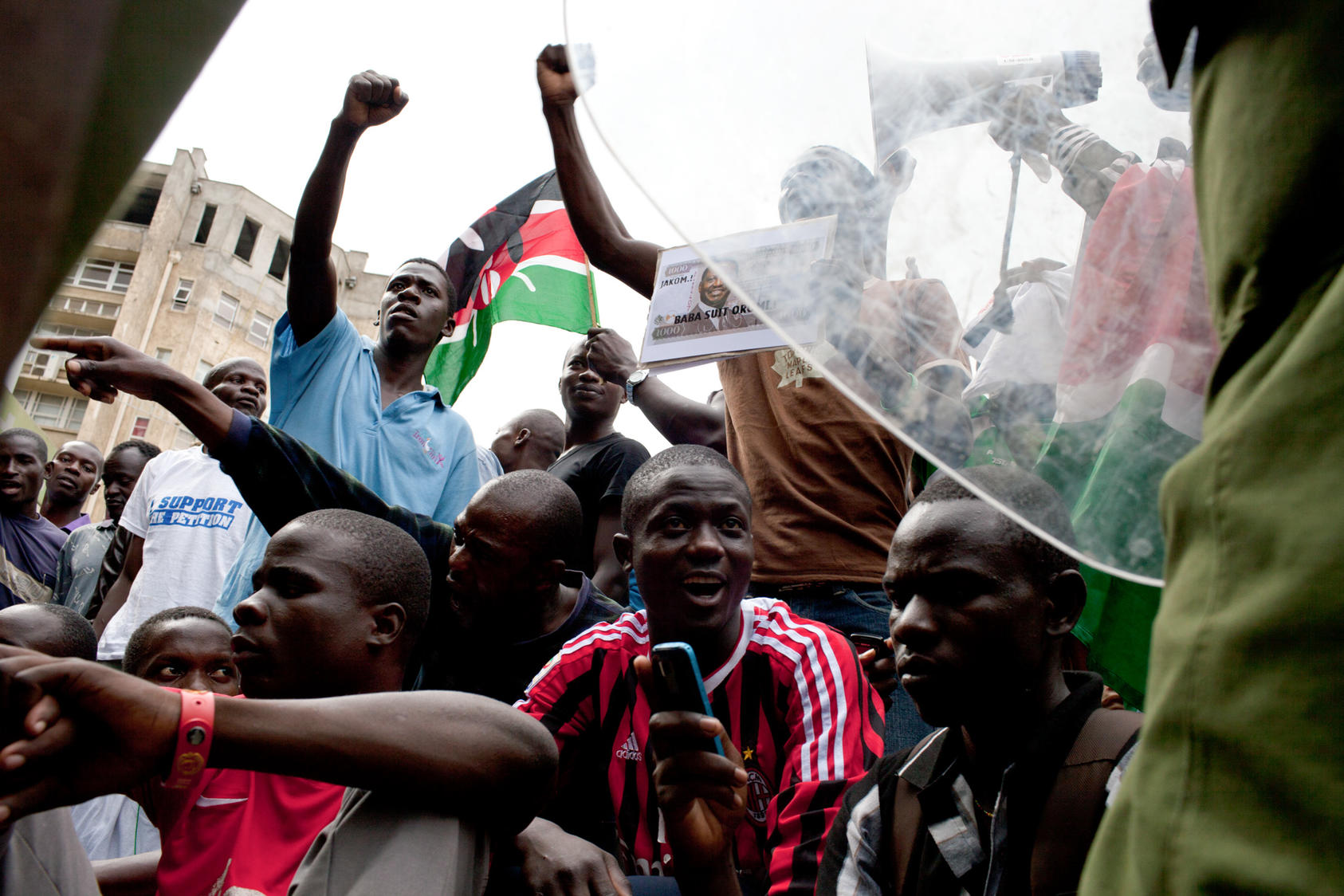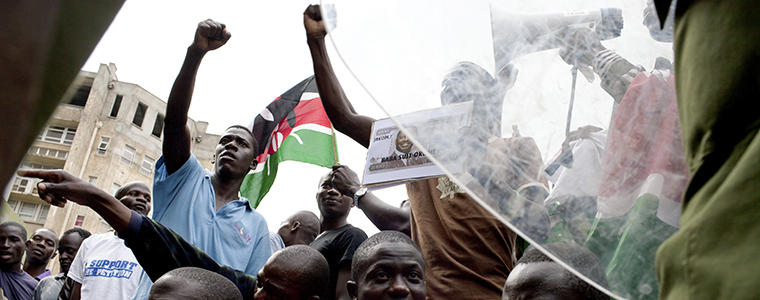On the Issues with Muhammad Fraser-Rahim
Kenyan President Uhuru Kenyatta’s first four years in office expire next year and he has announced he’s going to run for a second term in elections scheduled for August 2017. But the competition for power already is heating up.

While the 2013 campaign was largely calm, Kenyans talked about the country as a “ticking time bomb” in the post-election period. Through a series of dialogues with Kenyans in 2014, USIP found that narratives of fear and memory were the dominant explanations for why the country averted mass violence. Kenyans still recalled the devastating impact of previous episodes of conflict, particularly the 2007–08 post-election violence, a dynamic that resulted in restraint among the political elite and their support base four years later. But there is no guarantee that the “tense calm” of 2013 will repeat itself in this election cycle.
As U.S. Secretary of State John Kerry visits Kenya today, much of the frustration, anger and injustices that caused widespread violence in 2007 remain, and one year out, the 2017 contest is shaping up to be contentious amid public protests and a crackdown on civil society, opposition and refugees.
The opposition is led by Raila Odinga of the Coalition for Reforms and Democracy (CORD), which had accused the Kenyatta government of crimes against humanity over the 2007-08 post-election violence that killed 1,200 people. The International Criminal Court in 2014 dropped the case for lack of evidence. The violence in part had pitted Kenyatta’s Kikuyu ethnic group, the largest in Kenya, against the Luo, the group to which Odinga belongs.
Muhammad Fraser-Rahim, a USIP program officer for Africa, examines the key issues.
What is Kenya’s electoral lineup?
In 2013, Kenyatta teamed up with his previous rival, Deputy President William Ruto, to win power under the “Jubilee Alliance” umbrella. Earlier this year, the alliance was further consolidated into the “Jubilee Alliance Party.” As was the case that year, former Prime Minister Odinga poses the biggest challenge to Kenyatta this time. Odinga continues to claim that the last elections were rigged, and argues that, as in the previous election, the Independent Electoral and Boundaries Commission (IEBC) isn’t impartial.
What is the security situation in Kenya?
Tensions are rising. May and June 2016 saw violent protests demanding changes in the IEBC. Some Kenyan activists see the commission as an extension of the Kenyatta government, with limited ability to be impartial. The Kenyan government called for an end to the protests, saying parliament could conduct a hearing on public views about the election commission but that any dialogue “must be held within the confines of the law.” Within the past few weeks, CORD and Jubilee initiated a dialogue in response to protests and have proposed reforms in the electoral law. Though agreement is yet to be reached, the dialogue itself is a promising signal.
At the same time, concerns about human rights violations by security actors, including the police, continue. The week of June 26, a human rights lawyer who was working for an international non-profit organization and two taxi drivers were killed and their bodies were found in a river outside of Nairobi. The incident fueled allegations that the government is waging a crackdown on dissent.
What is the evidence for the alleged crackdown, and is it focused in particular parts of the country?
Several incidents point to the closing space in Kenya. In October 2015, the Non-Governmental Organization Coordination Board, a state agency, announced that it was initiating de-registration of over 900 NGO’s. Some organizations took the case to court, and the Kenyan government ultimately reversed the decision. However, the government has not yet implemented the new Public Benefit Organizations (PBO) Act passed in 2013 despite persistent advocacy by NGOs.
Civil society organizations in Kenya’s coastal areas—places such as Mombasa, Malindi, Lamu–have come under particular pressure. These are locations with large Muslim populations, and the government perceives these areas as fertile ground for recruitment by al-Shabab, the Somali extremist group. But the proof of any link of the civic organizations to terrorism is scant, so the official position amounts to imposing a kind of collective guilt rather than legal pursuit of individuals who might be culpable. The government says it’s trying to ease those concerns with steps such as unfreezing the accounts of organizations that it had targeted.
Human rights activists also are concerned that the government is too focused on security and that it will use the threat of violent extremism as an excuse to crack down, particularly on political opposition, in advance of the elections.
Is al-Shabab using the elections to target civilians or gain recruits?
According to observers in Kenya and terrorism experts in the region, al-Shabab continues to recruit disaffected and marginalized youth along the coast in Kenya. Al Shabab has capitalized on real and/or perceived grievances to recruit for further attacks throughout Kenya, and the group continuously adapts to find new ways to lure susceptible supporters inside the country.
What is likely to be the effect of the Kenyan government’s proposal to close the Dadaab refugee camp, the world’s largest, in the country’s northeast?
The Kenyan government’s plan to close the camp is based on the argument that it is a locus for al-Shabab recruitment and planning for terror attacks. But the proposed closure drew criticism from the United Nations, which warned of “potentially devastating consequences” for the 300,000-plus mostly Somali refugees.
After Kenyan officials made clear they were determined to proceed, the U.N. agreed to redouble efforts to safely repatriate refugees to their home countries. But questions remain, including the effect of the camp’s closure on the local economy. Most concerning, returning Somali refugees to a country that remains fragile and has limited ability to deliver basic services could have the opposite effect of Kenya’s stated goal to enhance security by making returnees more vulnerable and facilitating recruitment of new fighters by al-Shabab.
What can the United States do to encourage peaceful elections in Kenya?
Diplomatically, the U.S. government can strongly encourage the elections commission to follow through on its commitment towards electoral reform, and its promises of a credible and transparent vote. The U.S. can also call on political leaders to commit to peaceful elections and take steps to enhance space for political and civic voices to express their views on critical issues.
But prevention of election violence should always start at home. Kenyan civic organizations and institutions such as the National Cohesion and Integration Commission led robust efforts to map potential hotspots for election violence, monitor hate speech, conduct robust civic education and establish networks for early warning and early response. The U.S. can support promising Kenyan-led programs through financial and technical assistance.
USIP’s practice research has found that election observation is an effective approach to prevent election violence. The U.S. can integrate its efforts with other donors, like the European Union, in supporting well-established domestic observation networks like the Kenya Elections Observation Group and encourage international organizations like the Carter Center, the National Democratic Institute or the International Republican Institute to deploy long-term observation missions.
Even as attention turns to the elections, it’s also important for the U.S. and others in the international community to help the Kenyan government address the threat of violent extremism in a manner that effectively protects human rights.
In the coming months, there is a risk that peacebuilding efforts, democracy assistance, atrocity prevention, electoral violence prevention, countering violent extremism and conflict prevention will remain stove-piped. The forthcoming elections provide an opportunity to convene practitioners from these fields in joint conflict assessments and program design, to facilitate election programs that address root causes of violent political conflict in a way that will be sustainable.
